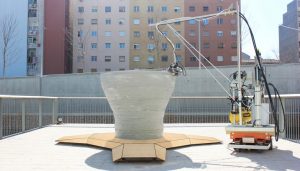 Most of the attention at this week’s Conexpo/IFPE show in Las Vegas focuses on everything from compact loaders to large excavators. On Thursday, officials from Spain will be discussing construction equipment on a much smaller scale that may eventually replace today’s much-larger machines.
Most of the attention at this week’s Conexpo/IFPE show in Las Vegas focuses on everything from compact loaders to large excavators. On Thursday, officials from Spain will be discussing construction equipment on a much smaller scale that may eventually replace today’s much-larger machines.
Researchers at the Institute for Advanced Architecture of Catalonia (IAAC), based in Barcelona, are currently exploring the potential of additive manufacturing in the construction field. And instead of trying to convert conventional equipment into mobile 3D printers, they’re looking to implement additive techniques on many pint-sized robots all working together to build large-scale structures.
Robotics offers great potential for innovation within the construction industry, said the IAAC team. However, current construction equipment shares a specific limitation: the objects they produce are constrained proportionally by the size of the machine. Typical construction robots, say to build a house, must have a work envelope on the same scale as the house itself.
In contrast, IAAC’s Minibuilders project aims to address this limitation by creating scalable techniques for fabricating structures using tools that are independent of the final product’s shape or size.
The project’s objective was to develop a family of small-scale, mobile construction robots capable of building objects far larger than the robot itself. Moreover, each robot performed a specific task, linked to different phases of construction. The robots worked independently but were all coordinated towards a single goal.
Specifically, researchers built three robots, each linked to sensors and a local positioning system. These feed live data into custom software that controls the robots’ movements and deposition of the material—in this case fast-setting artificial marble.
The first robot, the Base Robot, lays down the first ten layers of material to create a foundation. On-board sensors control direction so the robot follows a predefined path. A vertical actuator incrementally adjusts nozzle height for a smooth, continuous, spiraling layer.
To construct the main shell of the structure the second robot, the Grip Robot, attaches to the foundation. Four rollers clamp on the upper edge of the structure, letting it traverse along and deposit more material. The nozzle moves dynamically to ensure accurate output and create a curved structure. Heaters, integrated into the robot increase the local temperature to speed curing. The robot follows a predefined path, but can also adjust its path to correct errors within the printing process. Rotary actuators control height to maintain consistent layering.
Another major limitation of today’s additive manufacturing techniques is unidirectional layer orientation that creates inherent weakness. Additive manufacturing allows for heterogeneous, optimized material deposition. To take advantage of this and improve structural integrity, the researchers added a second layer over the shell closely aligned in the direction of stress.
Data from the structural analysis is then translated into paths for the third robot, the Vacuum Robot. Using a vacuum generator and suction, this robot attaches to the structure’s surface. Moving freely, it deposits material on the surface of the shell, further enhancing its structural properties. This task can be performed by one robot, or a swarm of coordinated robots working together.
The end result was a 1.5-meter high prototype structure printed in the exterior exhibition space of the Design Museum of Barcelona. Seven months of research were dedicated to project as part of the IAAC’s Open Thesis Fabrication postgraduate program.
Dori Sadan, a researcher at IAAC, will discuss the project, “Minibuilders – Small robots building large structures,” on Thursday at 10:03a.m. in Conexpo’s Tech Experience area.
Filed Under: News